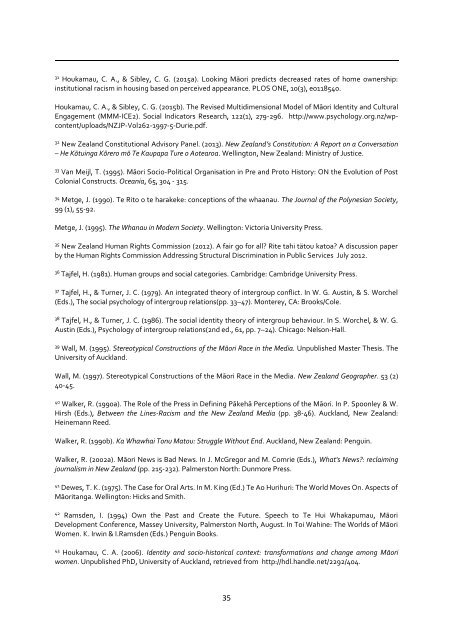UNCONSCIOUS BIAS AND EDUCATION
unconsious-bias-and-education
unconsious-bias-and-education
Create successful ePaper yourself
Turn your PDF publications into a flip-book with our unique Google optimized e-Paper software.
31<br />
Houkamau, C. A., & Sibley, C. G. (2015a). Looking Māori predicts decreased rates of home ownership:<br />
institutional racism in housing based on perceived appearance. PLOS ONE, 10(3), e0118540.<br />
Houkamau, C. A., & Sibley, C. G. (2015b). The Revised Multidimensional Model of Māori Identity and Cultural<br />
Engagement (MMM-ICE2). Social Indicators Research, 122(1), 279-296. http://www.psychology.org.nz/wpcontent/uploads/NZJP-Vol262-1997-5-Durie.pdf.<br />
32<br />
New Zealand Constitutional Advisory Panel. (2013). New Zealand’s Constitution: A Report on a Conversation<br />
– He Kōtuinga Kōrero mō Te Kaupapa Ture o Aotearoa. Wellington, New Zealand: Ministry of Justice.<br />
33<br />
Van Meijl, T. (1995). Māori Socio-Political Organisation in Pre and Proto History: ON the Evolution of Post<br />
Colonial Constructs. Oceania, 65, 304 - 315.<br />
34<br />
Metge, J. (1990). Te Rito o te harakeke: conceptions of the whaanau. The Journal of the Polynesian Society,<br />
99 (1), 55-92.<br />
Metge, J. (1995). The Whanau in Modern Society. Wellington: Victoria University Press.<br />
35<br />
New Zealand Human Rights Commission (2012). A fair go for all? Rite tahi tätou katoa? A discussion paper<br />
by the Human Rights Commission Addressing Structural Discrimination in Public Services July 2012.<br />
36<br />
Tajfel, H. (1981). Human groups and social categories. Cambridge: Cambridge University Press.<br />
37<br />
Tajfel, H., & Turner, J. C. (1979). An integrated theory of intergroup conflict. In W. G. Austin, & S. Worchel<br />
(Eds.), The social psychology of intergroup relations(pp. 33–47). Monterey, CA: Brooks/Cole.<br />
38<br />
Tajfel, H., & Turner, J. C. (1986). The social identity theory of intergroup behaviour. In S. Worchel, & W. G.<br />
Austin (Eds.), Psychology of intergroup relations(2nd ed., 61, pp. 7–24). Chicago: Nelson-Hall.<br />
39<br />
Wall, M. (1995). Stereotypical Constructions of the Māori Race in the Media. Unpublished Master Thesis. The<br />
University of Auckland.<br />
Wall, M. (1997). Stereotypical Constructions of the Māori Race in the Media. New Zealand Geographer. 53 (2)<br />
40-45.<br />
40<br />
Walker, R. (1990a). The Role of the Press in Defining Pākehā Perceptions of the Māori. In P. Spoonley & W.<br />
Hirsh (Eds.), Between the Lines-Racism and the New Zealand Media (pp. 38-46). Auckland, New Zealand:<br />
Heinemann Reed.<br />
Walker, R. (1990b). Ka Whawhai Tonu Matou: Struggle Without End. Auckland, New Zealand: Penguin.<br />
Walker, R. (2002a). Māori News is Bad News. In J. McGregor and M. Comrie (Eds.), What's News?: reclaiming<br />
journalism in New Zealand (pp. 215-232). Palmerston North: Dunmore Press.<br />
41<br />
Dewes, T. K. (1975). The Case for Oral Arts. In M. King (Ed.) Te Ao Hurihuri: The World Moves On. Aspects of<br />
Māoritanga. Wellington: Hicks and Smith.<br />
42<br />
Ramsden, I. (1994) Own the Past and Create the Future. Speech to Te Hui Whakapumau, Māori<br />
Development Conference, Massey University, Palmerston North, August. In Toi Wahine: The Worlds of Māori<br />
Women. K. Irwin & I.Ramsden (Eds.) Penguin Books.<br />
43<br />
Houkamau, C. A. (2006). Identity and socio-historical context: transformations and change among Māori<br />
women. Unpublished PhD, University of Auckland, retrieved from http://hdl.handle.net/2292/404.<br />
35


